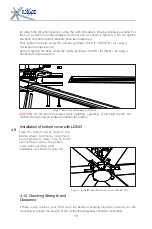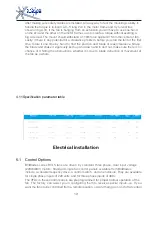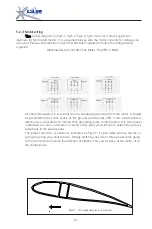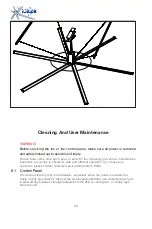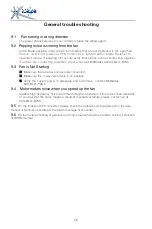
air column, upon reaching the floor, turns into a horizontal floor jet radiating out in all
directions. Under ideal conditions a 24' diameter overhead fans can serve up to
19,375sq/ft of floor space. Ideal conditions are: a fairly symmetrical area equates to
very few obstructions on the floor, and walls at the boundary of the area.
Obstructions on the floor, such us partitions or machinery tend to block the floor jet,
reducing the reach of the fan. The ideal center to center spacing, therefore, will vary
depending on the amount and size of these floor obstructions, as well as the nature of the
operations being conducted in the affected area and the construction of the building (i.e.
beams, etc.). In a manufacturing environment where there are many work stations each of
which must get good air movement, a solution is fans with close centers, running slowly.
For example, 24' long blade fans located on 60' centers, running at about 53rpm, might
be appropriate.
Conversely, in a warehouse where workers are moving around a lot and a little windiness
here and there is not a problem, 24' long blade fans on 110' centers might be suffice.
3.3.2 Vertical positioning
In many applications physical limitations——overhead cranes, low ceilings, etc.-dictate
vertical positioning, Where there is some latitude, here are the primary points to consider:
From a strictly performance point of view, 19.5' to 33' is the optimum height range for a
24' fan, but we have seen fans mounted as low as 9.75' and as high as 52.5' working
well. (HVLS fans should never be lower than 9.75' above the floor)
A fan must not be so close to the ceiling that is starved of air; it should be no less than
15% of its diameter from the ceiling. If the ceiling is pitched,the blades can come closer
on one side so long as there is ample open area on the other side.
If possible, fans should be high enough to be beyond the reach of forklifts and any long
material that workers might be handling.
Conversely, where fans are used to cool people working in just one part of very large
building with a very high ceiling, lower mounted fans may be in order. In such an extreme
case high mounted fans would re-circulate cooler air, leveling the hot air undisturbed.
12

















